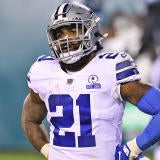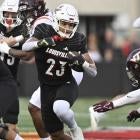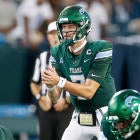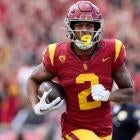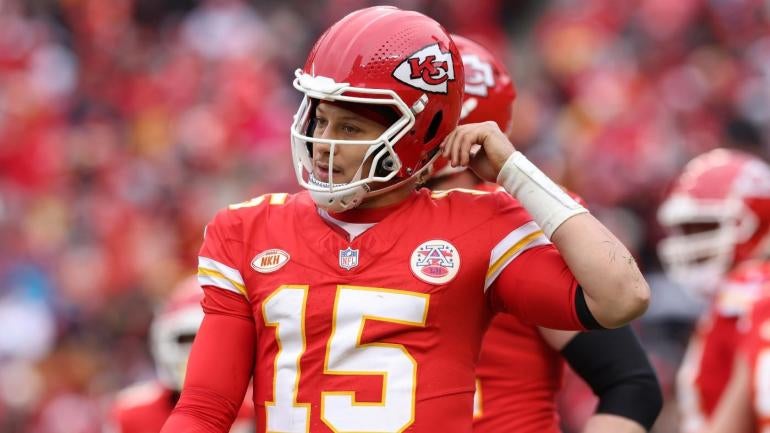
We have to ask: What is wrong with Patrick Mahomes and the Chiefs?
That home loss to the Raiders was about as ugly as we've seen in the Mahomes-Andy Reid era, and it's probably the single worst outing of Mahomes' career from an individual play perspective.
Ever since the five-turnover slopfest loss to the Broncos in Denver in Week 8, the Chiefs are 18th in offensive EPA per play and 20th in EPA per dropback. That's striking.
Starting with that 24-9 loss in Denver, the Chiefs are 3-5. The Week 12 win in Las Vegas was the only contest in which they scored 30 points in that stretch.
With the playoffs imminent, let's answer that vital question in the lede.
On Mahomes' play and the Chiefs' offensive identity
I'm starting here because the Chiefs' almost unrecognizable offensive problems have truthfully not all been due to Mahomes' surroundings. He has not played close to his normal standards.
Starting in Week 8, the two-time Super-Bowl winning quarterback has 12 big-time throws to 11 turnover-worthy plays, including a whopping five (the most in a single game in his career to date) in the Christmas Day defeat at the hands of the Raiders.
On the season, Mahomes' BTT rate is 3.8%, which is tied for 23rd among passers. And there are 20 qualifying quarterbacks with TWP rates lower than his current 3.1%.
During his erupt-onto-the-scene 2018 campaign, when he cruised to the MVP award, his TWP rate was 3.2%. But he countered that with a monstrous 7.3% BTT rate.
Mahomes has gone from one of the most aggressive downfield throwers, which exquisitely aligned with his bazooka arm, to a dink-and-dunk passer.
In 2018, Mahomes' average depth of target (aDOT) was 9.5 yards, the seventh-highest in the league. That year, he led the league with 75 completions that accumulated 20 or more yards, which equated to an average of more than 4.5 explosive passes per game.
Mahomes' aDOT stayed near nine yards -- which is typically an aDOT near the highest in the league -- the next two seasons, but the following two seasons after that, it dipped below 8.0 yards. And now Mahomes is tied for the fourth-lowest aDOT in football at 6.9 yards. The byproduct? He has 45 completions that've gone for 20-plus yards after 15 contests this season, meaning the Chiefs are getting about three explosive pass plays per game. That's a 33.3% decrease from 2018.
Now, of course, we shouldn't have expected Mahomes and the Chiefs to churn out 2018-level efficiency every season. That was one of the most prolific quarterback seasons in NFL history. But it did occur in Year 2 for Mahomes. Travis Kelce turned 29 that season and Tyreek Hill was only 24 years old. Goodness gracious.
This year, Mahomes and the Chiefs' game plan have had a foundation in underneath throws and yards after the catch. Mahomes not operating as surgically and turning over the football at nearly the highest rate of his career are huge reasons why Kansas City is barely treading water of late on offense.
On the Chiefs' supporting cast
Yes, drops have been a problem for the Chiefs all season. But they're hardly happening at an unprecedented clip. Mahomes has dealt with a drop rate of 6.9%, tied for the 13th-highest in football. Now, Mahomes has endured the most drops in the NFL, but he's also thrown the most passes (568) entering Week 17, making for a prime example as to why rate statistics are usually more informative than counting statistics.
Instead of showing one play to help push a point, trust me when I write that the likes of Rashee Rice, Justin Watson, Kadarius Toney, Skyy Moore, Marquez Valdes-Scantling, Mecole Hardman, and Richie James do not together form a dynamic group of explosive separators. And Watson has probably been the most steady separator of the bunch, believe it or not. But have those receivers essentially always been covered? No. Reid has still done a marvelous job scheming YAC, and Mahomes has largely gotten it into the hands of the correct, intended receiver throughout the season.
Kansas City is second in football in YAC per grab with an average of 6.3 yards.
Despite battling through injuries at 34 years old, Kelce is again having a monstrous season. And he gets open often. Plus, his 17 forced missed tackles are the second-most among tight ends, and his 90 catches are third-most at the position.
Up front, Mahomes has been pressured 35.4% of the time, which is right around his normal pressure rate and basically in the middle of the pack among qualifying quarterbacks. But that doesn't tell the whole story for the offensive line. It's a group that until recently was fully intact but "leads" football with 20 offensive holding penalties.
And after quietly emerging in 2022 with a high-caliber rushing attack, mostly due to the pulverizing interior of center Creed Humphrey and guards Joe Thuney and Trey Smith -- when they finished the regular season 10th in rush EPA per play -- the Chiefs have regressed on the ground. Kansas City's running offense is 21st in EPA per play on the year and 23rd starting in Week 13. In that span, the Chiefs have lost three of four.
Mistakes
Many times, particularly with good and great teams, struggles simply stem from costly mistakes. While I've outlined how and why blame deserves to be spread around, the mistakes for Kansas City this season have come in some enormous, game-altering moments, like the MVS drop in the end zone against the Eagles, and of course Toney's offsides penalty against the Bills.
The Chiefs currently have the league's worst turnover differential at -10. It was -3 at the end of the 2022 regular season.
What isn't so simple to discern is whether or not costly mistakes -- turnovers and penalties -- are genuinely a characteristic of a team or just fluke plays occuring at inopportune times.
If it's the former, that's a massive, lurking issue. If it's the latter, there's light at the end of the tunnel.
Summary
The last time I outlined prolonged problems for the Chiefs offense came in 2021 for a slideshow video on the CBS Sports Instagram, when Mahomes had eight interceptions in his first six games out of the gate. He was picked just five times after that and countered with 20 touchdown passes. Kansas City went 12-5, earned the No. 2 seed in the AFC, and lost in a bizarre conference championship game at home -- a contest in which they led 21-10 at the half.
While it's true the 2021 Chiefs don't have much to do with the 2023 Chiefs, there are two central figures still present: Mahomes and Reid. They should provide hope to Chiefs fans everywhere. But they can't do it alone and must be better themselves.
So what's wrong with the Chiefs? Particularly in the post-Tyreek Hill era in Kansas City, the club has made YAC on quick, underneath throws the utmost priority offensively. It's likely why Moore and Rice were drafted and the club traded for Toney. They all were YAC specialists in college.
This season, while the YAC has been there, Mahomes' play has dipped when throwing to the other levels of the field; his 35% adjusted completion rate on deep throws (20-plus yards) is the lowest of his career and 31st in the NFL.
Kansas City's blocking has been average at best, and the unit is holding too frequently. Altogether, it feels like everyone has contributed to the rash of turnovers that've led to the -10 turnover differential.
As such a downturn for one of the league's most electric offenses would indicate, the Chiefs' offensive woes are a group effort.













